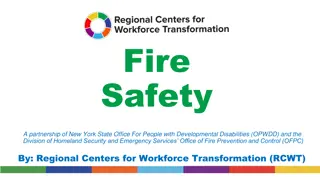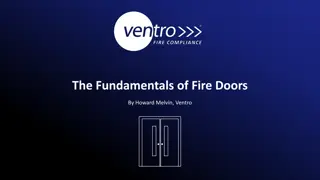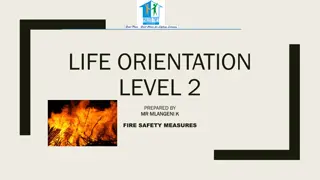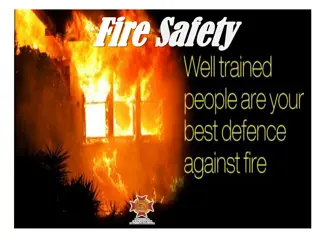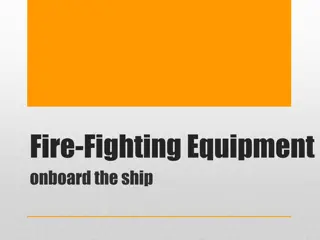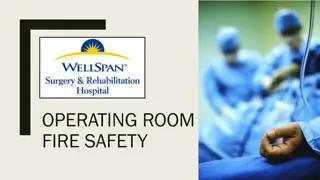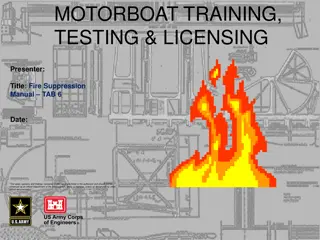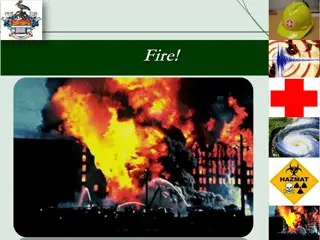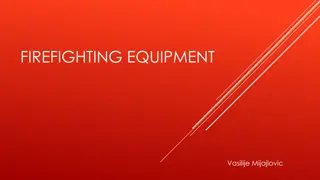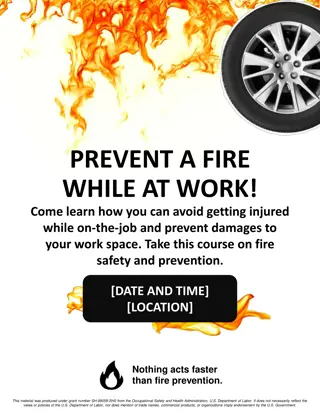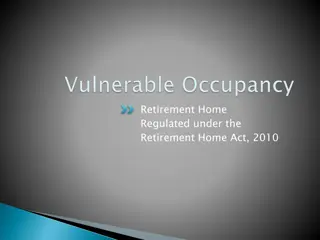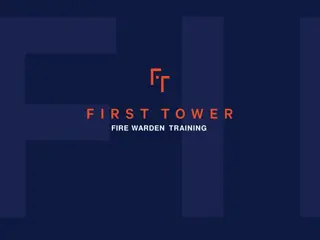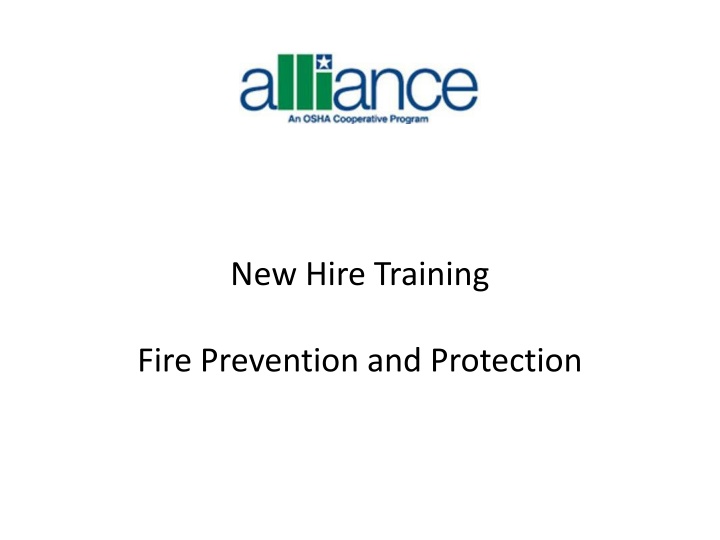
Fire Prevention and Protection Training Essentials
Learn about the crucial aspects of fire prevention and protection training, including developing a fire protection program, fire prevention plan requirements, understanding fire hazards, and essential tasks for fire protection to ensure workplace safety and compliance with OSHA regulations.
Download Presentation

Please find below an Image/Link to download the presentation.
The content on the website is provided AS IS for your information and personal use only. It may not be sold, licensed, or shared on other websites without obtaining consent from the author. If you encounter any issues during the download, it is possible that the publisher has removed the file from their server.
You are allowed to download the files provided on this website for personal or commercial use, subject to the condition that they are used lawfully. All files are the property of their respective owners.
The content on the website is provided AS IS for your information and personal use only. It may not be sold, licensed, or shared on other websites without obtaining consent from the author.
E N D
Presentation Transcript
New Hire Training Fire Prevention and Protection
Fire Protection and Prevention Your employer is responsible for the development of a fire protection program and must also provide firefighting equipment. At a minimum, your fire prevention plan must include: A list of all major fire hazards, proper handling and storage procedures for hazardous materials, potential ignition sources and their control, and the type of fire protection equipment necessary to control each major hazard. Procedures to control accumulations of flammable and combustible waste materials. Procedures for regular maintenance of safeguards installed on heat- producing equipment to prevent the accidental ignition of combustible materials. The name or job title of employees responsible for maintaining equipment to prevent or control sources of ignition or fires. The name or job title of employees responsible for the control of fuel source hazards.
Fire Prevention Plan FPP requirements: Must be In writing Kept in the workplace Available to employees for review Employer must Inform employees of fire hazards they are exposed to when initially assigned to a job Review with each employee applicable FPP parts required for self-protection Source: OSHA
Fire Prevention Plan Preventing fires hazards: In order to prevent fires, it is important to understand how fires occur. Fire is a very rapid chemical reaction between oxygen and a combustible material, which results in the release of heat, light, flames, and smoke. For fire to exist, the following four elements must be present at the same time: o Enough oxygen to sustain combustion. o Enough heat to raise the material to its ignition temperature. o Some sort of fuel or combustible material. o The chemical reaction that is fire. Source of graphics: OSHA
Fire Prevention Plan Tasks that require fire protection and examples of hazards Hotwork (welding, cutting, brazing) fire watch: Fire watches are used to prevent and/or extinguish fires at the incipient (beginning) stage. They monitor the hot work sites to ensure that conditions do not change when combustible materials cannot be effectively removed, protected or shielded. Fire watches also require specialized training and are assigned to minimize damage that may be caused by a fire. If a fire occurs, they take appropriate actions to protect all workers. Source of graphics: OSHA
Fire Prevention Plan Tasks that require fire protection and examples of hazards Dispensing: When transferring liquids, gases, or solids through pipes or hoses, static electricity may be generated, creating an electric charge that can ignite the flammables. It is necessary to bond containers when flammables are being transferred from one to the other and have the receiving container in contact with the ground so that the static can be effectively eliminated and, thereby, remove the ignition source. Source of graphics: OSHA
Fire Prevention Plan Tasks that require fire protection and examples of hazards Flammable wastes: Dispose of oils, paint thinners, solvents, rags, scraps, waste, or other flammable and combustible substances, or store them in covered fire-resistant containers, at the end of each workshift or when the job is complete, whichever occurs first. Source of graphics: OSHA
Fire Emergencies Fight or Flee? Portable fire extinguishers have two functions: to control or extinguish small or incipient stage fires and to protect evacuation routes that a fire may block directly or indirectly with smoke or burning/smoldering materials. To extinguish a fire with a portable extinguisher, a person must have immediate access to the extinguisher, know how to actuate the unit, and know how to apply the agent effectively. Attempting to extinguish even a small fire carries some risk. Fires can increase in size and intensity in seconds, blocking the exit path of the fire fighter and creating a hazardous atmosphere. In addition, portable fire extinguishers contain a limited amount of extinguishing agent and can be discharged in a matter of seconds. Therefore, individuals should attempt to fight only very small or incipient stage fires. Source: OSHA Prior to fighting any fire with a portable fire extinguisher you must perform a risk assessment that evaluates the fire size, the fire fighters evacuation path, and the atmosphere in the vicinity of the fire.
Extinguishing Fires When used properly, fire extinguishers can save lives and property by putting out a small fire or controlling a fire until additional help arrives. A fire is the most common type of emergency for which small businesses must plan. A critical decision when planning is whether employees should fight a small fire with a portable fire extinguisher or simply evacuate. Portable fire extinguisher training and education Required for employees authorized to use fire extinguishers Describes general principles of fire extinguisher use Describes hazards of incipient stage fire fighting Describes operation of equipment (instruction and hands-on practice) Required upon initial employment/assignment and at least annually thereafter Source: OSHA
Extinguishing fires Classes of fires Class A Fires Fires inordinary combustibles,such as wood, paper, cloth, rubber and many plastics. Class A extinguisher : Water and foam fire extinguishers. Water extinguishers are for Class A fires only Class B Fires Fires inflammable liquids orflammable gases. DOES NOT includefires involvingcooking oilsandgrease. Class B extinguisher: Cartridge operated dry chemical fire extinguisher. A carbon dioxide fireextinguisherworks on aClassB fire by expelling CO2 to suffocate the fire, removing the oxygen necessary to keep it burning. It also helps with removing the heat, as the discharge is very cold. Ordinary dry chemical is for Class B and C fires only. Class C Fires Fires involvingenergized electrical equipment. Remove the power and a Class C fire becomes one of the other classes of fire. Class C extinguishers: Clean Agent Fire Extinguishers. Halogenated or clean agent extinguishers include the halon agents as well as the newer and less ozone depleting halocarbon agents. They extinguish the fire by interrupting the chemical reactionand/or removingheatfrom the fire triangle. Clean agent extinguishers are effective on Class A, B and C fires.
Extinguishing fires Classes of fires Class D Fires Fires incombustible metals, such as magnesium, titanium, zirconium, sodium, lithium and potassium. Class D extinguishers: Dry Powder Fire Extinguishers. Dry powder extinguishers are similar to dry chemical extinguishers except that they extinguish the fire by separating thefuelfrom the oxygen element or by removing theheatelement of the fire triangle. Dry powder extinguishers are for Class D or combustible metal fires ONLY.They are ineffective on all other classes of fires. Class K Fires Fires involving vegetable oils, animal oils, or fats in cooking appliances. They use a process called saponification (turn fat or oil into soap by reaction with an alkali)by releasing an alkaline agent to create a foam that traps vapors and puts the fire out. Most portable extinguishers are rated for use with more than one classification of fire. For example, an extinguisher with a BC rating is suitable for use with fires involving flammable liquids and energized electrical equipment. An extinguisher with an ABC rating is suitable for use with fires involving ordinary combustibles, flammable liquids and energized electrical equipment. An extinguisher that is rated for use with multiple hazards should include a symbol for each hazard type.
Extinguishing Fires Using a fire extinguisher: The following steps should be followed when responding to incipient stage fire: 1.Sound the fire alarm and call the fire department, if appropriate. 2.Identify a safe evacuation path before approaching the fire. Do not allow the fire, heat, or smoke to come between you and your evacuation path. 3.Select the appropriate type of fire extinguisher. 4.Discharge the extinguisher within its effective range using the P.A.S.S. technique (pull, aim, squeeze, sweep). 5.Back away from an extinguished fire in case it flames up again. 6.Evacuate immediately if the extinguisher is empty and the fire is not out. 7.Evacuate immediately if the fire progresses beyond the incipient stage.
Extinguishing Fires P.A.S.S. technique Pull the pin Aim at base of fire Squeeze handle Sweep side-to-side at base of fire until fire appears out Watch area for re-ignition and repeat steps 2 4; When in doubt, EVACUATE IMMEDIATELY! Source: OSHA
Summary We discussed the elements of an effective fire protection plan and what the employers' obligations are. We discussed the five types of fire extinguishers and the types of fires they will be effective on. We also talked about knowing when to fight a fire or flee to safety. Being familiar with the fire protection plan will save lives.
Through the Alliance between OSHAs 10 Regional Offices and the Elevator Contractors of America (ECA), Elevator Industry Work Preservation Fund (EIWPF), International Union of Elevator Constructors (IUEC), National Association of Elevator Contractors (NAEC), National Elevator Industry Educational Program (NEIEP), and National Elevator Industry Inc. (NEII), collectively known as The Elevator Industry Safety Partners, developed this Industry Specific Training for informational purposes only. It does not necessarily reflect the official views of OSHA or the U.S. Department of Labor. March 2025 Under the Occupational Safety and Health Act, employers are responsible (http://www.osha.gov/as/opa/worker/employer-responsibility.html) for providing a safe and healthy workplace and workers have rights (https://www.osha.gov/workers). OSHA can help answer questions or concerns from employers and workers. OSHA's On-Site Consultation Program (https://www.osha.gov/consultation) offers free and confidential advice to small and medium-sized businesses, with priority given to high-hazard worksites. For more information, contact your regional or area OSHA office (https://www.osha.gov/contactus/bystate), call 1-800- 321-OSHA (6742), or visit https://www.osha.gov/.

